Jim O'Dea, a carving instructor and a familiar name to members of the carving community, is the coordinator of the annual Lake Placid Woodcarving Experience. Over the years, he has put together a group of well-known instructors with very diverse carving backgrounds. There is (orwill be) a class available for any type of carving—from a full-bust sculpture, to woodburning (pyrography), caricature, historical reproduction, and nearly any subject in between. Classes unrelated to carving are also available to "noncarving" spouses, and after-class activities are available to anyone who attends the event.
Classes range from three to five days (depending on the class) and the instructor's fee is paid on fhe first day of class.
Every year, this event is held in September at the North-woods Inn in Lake Placid, New York—a delightful setting to further one’s craft in a region that has been rated as one of the “Top 10 Great Places on Earth You Do Not Want to Miss" by USA Today. Jim and Gary Smith (the owner of the Northwoods Inn) have expanded this event over the last three years and have wide-ranging plans for fufure expansion.
Here are some photos of the workshops that were held during the event.
Mountain Man and Wolf
The theme was the result of collaboration between Leah Goddard and Chris Howard. Their project, Mountain Man and Wolf, began as a roughout, but allowed the caiver some freedom of personal expression. It was the featured project for fhe 2012 Lake Placid Woodcarving Experience and will remain on display af the inn.
- The instructors, Leah and Chris, present a project full of challenges and give each carver personal assistance along the way to completing the project.
- Carvers know how important it is to establish the dements of a face. This is where Chris begins his portion of 'he workshop—explaining how, why, and where the Pmportions are related.
- Through mapping the locations of the face, he ffaphically points out the essentials.
- Once everything Is clear and well defined: the pupils are set.
- All the landmarks are in place and the refinern| begins.
- Here. Chris is explaining where the upper lip beg^ form.
- Then he proceeds to graphically outline how the eyes, and mouth relate.
- Once his reference marks are established, he moves to the bridge of the nose and eye mounds and begins the primary shaping.
- Both instructors give thorough explanations regarding how each tool applies to the intended cut.
- The next major step is to make a stop cut at the base of the nose.
- Now that the foundation is built, it is a matter of refinement and detail for the rest of the project.
- Dick Zawacki is establishing inner ear detail on the wolf.
- There is no shortage of time for a small group or individual attention; both Chris and Leah provide as much help as the students need.
- How and where to define the lips are a few of the many steps that are covered.
- Here, Leah is explaining the proper blade a making the first eye cut. A common mistake m many carvers is undercutting with the first cut.
- The finished project.
- Jim gives thorough explanations about the position size, and proportion of facial features to two of hi students, Glen Durlacher and Nancy Del-Zio.
- Jim’s method starts with each step being numbered and the reference points marked.
- Then it is merely a matter of removing the wood—how simple can it get?!
- There it is in a nutshell, or should I say in a basswood study stick?
- Sharon delivers a simple, down-to-earth, and thorough explanation of tool temperature, tip style, and stroke, and she offered many examples of how they work together.
- John Wagner develops his skills on a tree pattern.
- Then he moves on to a blue jay.
- Carl Borst of Rotterdam, New York, is a carver who specializes in historic reproduction and instructed students how to carve a Bellamy-Style Eagle.
- Carl explains the use of a gouge to Ed Shouldis. From rough outline to finishing, Carl presents the student with a firm basis of design and technique that will enhance any carver’s skill level.
- Ed displays the use of his new skill set.
- Like most carvers, Carl is always on the lookout for new tools. These are recycled golf club handles that have been repurposed by Marcus Kruger of Tribes Hill, New York.
- The secret to repurposing the golf club handles is in the tempering process—a process that Marcus studied and experimented with until he finally got the right combination of heat, oil, and color. Carl reports that the golf club tools are a joy to use and is looking forward to the larger sections of the shaft that Marcus is preparing.
- Chris is showing an example of the Pot O'Sunshine' that the students worked on. In the photo, Corinne Joger is the left rear, Anka Crowe is next to her, and Sandy Corruthers is next to Chris.
















Human Face Study Sticks
As students carved Jim O'Dea's Human Face Study stick they learned the proper development of a face as applied to both lifelike and caricature carvings.




Pyrography (formerly known as Woodburning)
Sharon Bechtold taught the pyrography class—another technique that is applied to many carvings and an art form in its own right.




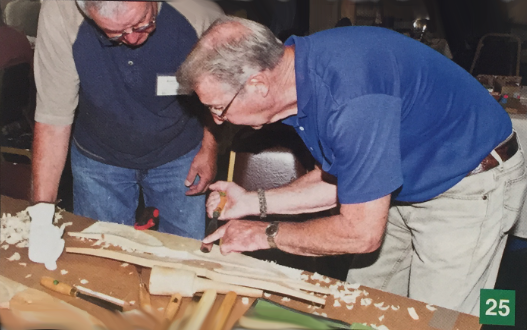
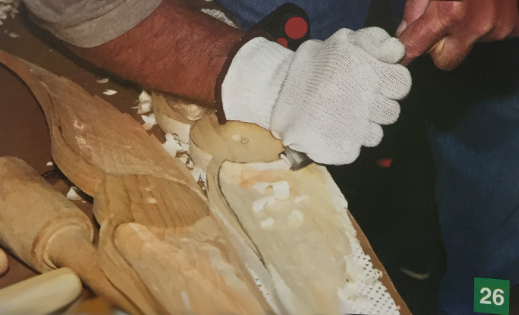
Historic Reproduction
Historic reproduction is always a challenge for carvers. Oftentimes, individuals or local businesses commission certain pieces and leave the execution up to the carver.
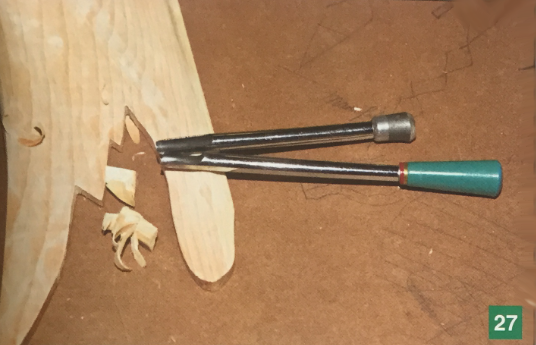
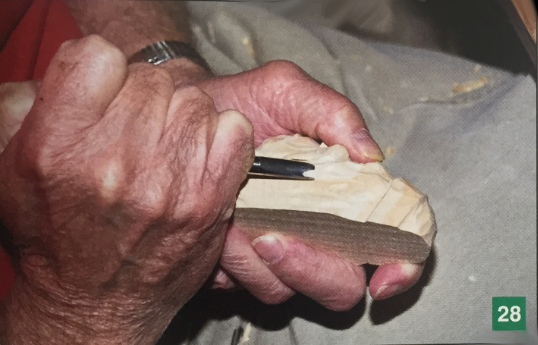
Classes Unrelated to Carving
Although, at this time, there is not a Mj schedule of classes for “noncarvers, during the 2012 event, there were short classes on scrapbooking, beading, anC* making wire jewelry, and Chris O'D®0 (Jim’s wife) held quilting classes. Th® group discussed the basics of quilting cut out pieces of a quilt pattern, whic they completed at home.
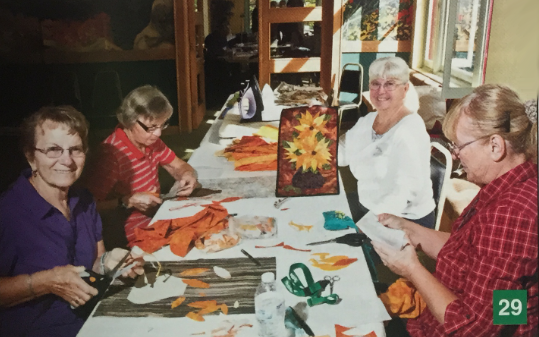
The well-presented event was extremely enjoyable, and the instructors were not only informative and educational, but they were also fun.
Gary Smith was a gracious host and went well beyond everyone's expectations. He hosted a barbecue at his home and offered well-planned evening activities (available to anyone who attended the event) throughout the week.
By Wes Demarest
Wes Demarest is a frequent contributor to Carving Magazine.

